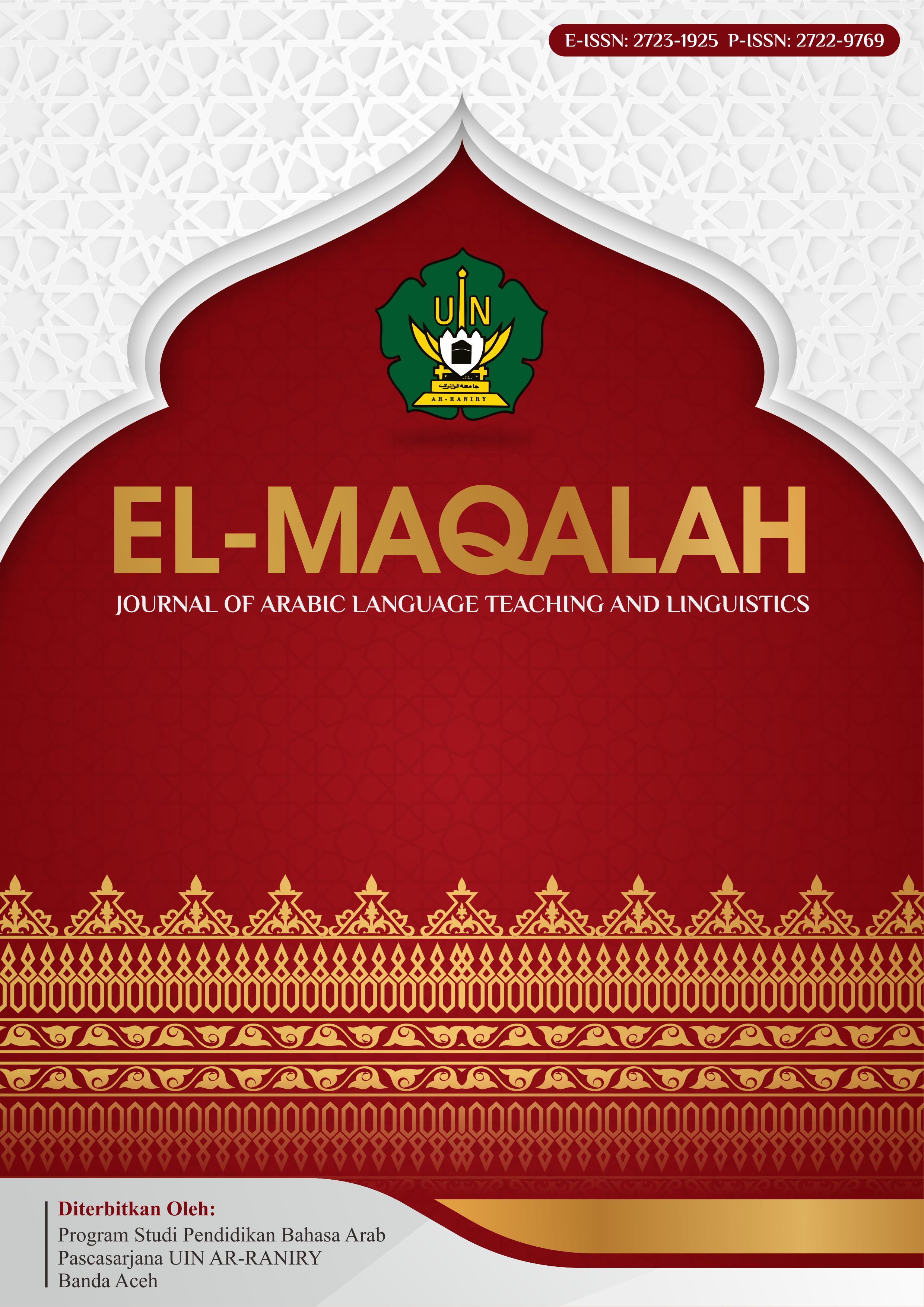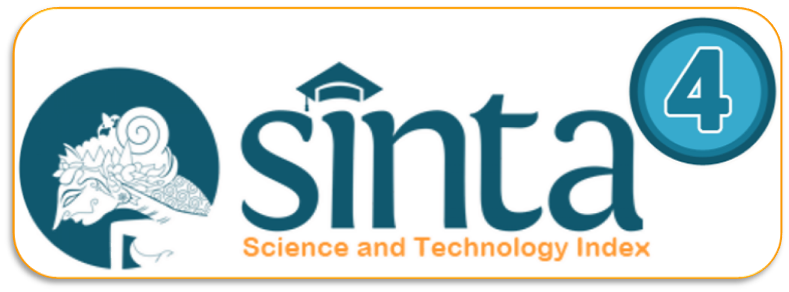Ta`līm al-Qawā`id an-Naḥwiyyah Bi aṭ-Ṭarīqah al-Istiqrāiyyah `Alā Asās al-Madkhal al-`Ilmī Bi Ma`had al-Muhājirīn Aceh Besar
Aceh Besar تعليم القواعد النحوية بالطريقة الاستقرائية على أساس المدخل العلمي بمعهد المهاجرين
DOI:
https://doi.org/10.22373/maqalah.v4i2.3806Keywords:
Nahwu Grammatical, Istiqraiyah Method, Scientific ApproachAbstract
Arabic has two grammars, nahwu, and sharaf. Nahwu specializes in the rule of changing word endings, while Sharaf focuses on word changes. The use of nahwu helps with determining each function of every word in a sentence, the adjustment of word endings, and their positions. Therefore, nahwu is fundamental in learning Arabic. When learning activities took place in the female class VII- A at Junior High School Al-Muhajirin, the initial process was conducive. The teacher taught students by applying the istiqraiyah method. However, the situation in the classroom changed after 30 minutes, especially for students sitting in the back. Some of them ate snacks, talked to each other, and fluttered using books although the room’s temperature was normal. The circumstance happened because the learning activity was teacher-centered, the teacher was more active than the students. This study aimed to apply the Istiqraiyah method based on the scientific approach in learning nahwu, to find out students' responses on the application of the method and to know the influences of the istiqraiyah method based on the scientific approach in grammar learning in each cycle. The researcher applied the classroom action research (PTK). The population of this study was 172 students. The study sample was female students in class IX-a. There were 36 students. The researcher carried out observations, and tests, and provided questionnaires. The findings of this study were: 1) The implementation of the istiqraiyah method based on the scientific approach was very effective. The teacher observation result in the second circle (94,21%) was higher than the first circle (89,47%). The student observation result in the second circle (93,75%) was higher than the first circle (88, 75%). 2) The students’ responses to the istiqraiyah method based on the scientific approach in learning the nahwu grammatical structure at Dayah Al-Muhajirin were very good. The result of the students' responses in the second circle (86, 11%) was higher than the first one (79,73%). 3) The influences of the istiqraiyah method based on the scientific approach in the nahwu grammar learning at Dayah Al-Muhajirin were effective in improving students' nahwu grammatical skills. The result of the student test in the first cycle (70, 31%) was higher than the test in the pre-cycle (46, 25%). The result of the student test in the second cycle (84,37%) was higher than the student test in the first cycle (70,31%).
References
al-Azīz, Ṣālih `Abd. at-Tarbiyyah Wa Ṭuruq at-Tadrīs. al-Qāhirah: Dār al-Ma`ārif, 1961.
al-Ḥamīd, Muḥyi ad-Dīn `Abd. at-Tuḥfah as-Sunniyyah Syarḥ al-Ajrūmiyyah. ar-Riyāḍ: Dār as-Salām.
al-Hāsyimī, `Abd ar-Raḥmān. Ta`līm an-Naḥw Wa al-Imlā’ Wa at-Tarjamah. `Imān: Dār al-Manāhij Li an-Nasyr Wa at-Tauzī`, 2008 M.
Al-Jāhiẓ. al-Bayān Wa at-Tibyān. al-Qāhirah: al-Istiqāmah, 1375 H.
al-Khuḍrī, Muḥammad Ibn Muṣṭafā. Ḥāsyiyah al-Khuḍrī `Alā Syarḥ Ibn `Aqīl. Miṣr: Dār al-Fikr.
al-Līmī, Ṭāhā `Alī Ḥusain Wa Akharūn. al-Lughah al-`Arabiyyah Manāhijuhā Wa Ṭarāiq Tadrīsihā. Baghdād: Dār asy-Syurūq, Jāmi`ah Baghdād, 2005.
as-Sa`īd, Sa`īd Muḥammad. Ṭuruq at-Tadrīs al-`Āmmah Takhṭīṭuhā Wa Taṭbīqātuhā at-Tarbawiyyah. `Imān: Dār al-Fikr Nāsyirūn.
as-Sāmirī, Hāsyim Jāsim. al-Manāhij Wa Ṭarāiq at-Tadrīs. Ḥaḍramaut: Jāmi’ah al-Aḥqāf, 1420 H.
Bādī, Ghasān Khālid. Taḥdīd Ma`nā Ṭarīqah at-Tadrīs Fī Iṭār `Ilmī Mutaḥaddid “Buḥūṡ Tarbawiyyah Wa Nafsiyyah. Makkah al-Mukrramah: Jāmi`ah Umm al-Qurā, 1946.
Daryanto. Pendekatan Pembelajaran Saintifik Kurikulum 2013, Yogyakarta: Gava Media, 2014.
Hosnan, Pendekatan Saintifik dan Konstektual dalam Pembelajaran Abad 21. Bogor: Ghalia Indonesia, 2016.
Ibn `Alī, Muḥammad Ibn Mukarram (Ibn Manżūr). Lisān al-`Arab. Bairūt: Dār Ṣādir, 1414 H.
Iskandar. Penelitian Tindakan Kelas, Cet. I, Ciputat: GP Press Group, 2012
Jinnī, Ibn. al-Khaṣāiṣ. al-Qāhirah: Dār al-Kutub al-Miṣriyah, 1913.
Kemendikbud, Pendekatan Scientifik (ilmiah) dalam Pembelajaran. Jakarta: Pusbangprodik, 2013.
Ma`rūf, Nāif. Khaṣāiṣ al-`Arabiyyah. Bairūt: Dār an-Nafāis, 1985 M.
Mazkūr, `Alī Aḥmad `Alī. Tadrīs Funūn al-Lughah al-`Arabiyah. al-Qāhirah: Dār al-Fikr al-`Arabī, 2002.
Neliwati, Pengembangan Kurikulum Pendidikan Agama Islam, Medan: FITK, 2015.
Ni`mah, Fuād. Mulakhkhaṣ al-Lughah al-`Arabiyyah. Bairūt: Dār al-Munāfaqah al-Islāmiyyah, Bidūn as-Sanah.
Nur. M, Teori-teori Pengembangan, (Surabaya: Institud Keguruan dan Ilmu pendidikan, 1998.
Samiudin, Peran Metode" Jurnal Studi Islam. Vol. 11, No 2, 2016, 120
Syaḥātah, Ḥasan. Ta`līm al-Lughah al-`Arabiyah Baina an-Naẓariyah Wa aṭ-Ṭaṭbīq. Lubnān: Dār al- Miṣriyah al-Lubnāniyah, 1993.
Yunus Abidin, Desain Sistem Pembelajaran dalam Konteks Kurikulum 2013. Bandung: Refika Aditama, 2014.




























